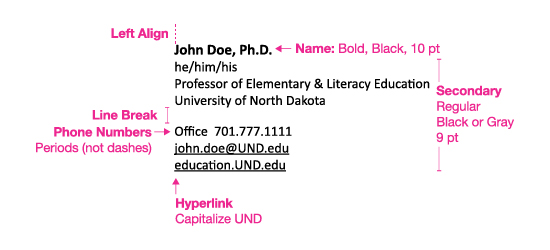Email Signatures
An email signature is your digital business card.
It's important to present your email signature in a professional and unified manner, just as you would with your traditional printed business card.
What to Include in Your Email Signature
Required
- Name
- Phone Number
- University of North Dakota
Recommended
- Position/Title
- School/College/Department
- Street Address
- URL
Optional
- Room Number
- Fax Number
- Additional Phone Numbers
- Pronouns
Be sure to include your updated signature on your Microsoft Outlook and Office 365 accounts.
Signature Examples
Condensed Signature
John Doe, Ph.D.
Professor of Elementary & Literacy Education
University of North Dakota
Office 701.777.1111
john.doe@UND.edu
education.UND.edu
Full Signature
John Doe, Ph.D.
he/him/his
Professor of Elementary & Literacy Education
College of Education & Human Development
University of North Dakota
Education Building, Room 300
231 Centennial Dr Stop 7189
Grand Forks, ND 58202-7189
Office 701.777.1111
Dept 701.777.2222
Cell 701.550.1111
Toll-free 1.800.777.3333
Fax 701.777.4444
john.doe@UND.edu
education.UND.edu
How to Format Your Signature
Name Selection
- Color: Black
- Format: Bold
- Size: 10 pt or the same size as the body content. Do not exceed 12 pts.
- Left align
Title and Contact Information
- Color: Black or Gray
- Format: Regular
- Size: 9 pt or one point size smaller than the name.
- Breaks: Group related contact information by line breaks for easy scanning.
- Left align
- Phone and fax use periods, not dashes
- Hyperlink email and web address (capitalize UND)

Color
Do not use colors outside of black or gray. Using color does not create a consistent signature across various email systems.
Confidentiality Disclaimer and Other Disclaimers
Include confidentiality clauses and other disclaimers based on position and department needs. Disclaimers used by a unit should be consistent from signature to signature.
Disclaimers recommendations:
- Location - a line return or two under your email signature
- Size - match the size of your contact information
- Color - black or dark gray
Font
Do not use scripts or novelty fonts. Use calibri (default in Outlook). If calibri is not available, use arial or basic sans-serif font.
Labels
Use the following labels to identify your contact information:
- Office
- Dept
- Cell
- Toll-free
- Fax
If the only phone number listed is your personal office, you can eliminate the Office label.
Land Acknowledgment
UND’s Land acknowledgment can be included. The full statement can be written out or you can link to the full statement. The statement cannot be altered in any way.
Disclaimer recommendations:
- Location — a line return or two under your email signature
- Size — match the size of your contact information
- Color — black or dark gray
Logos and Graphics
- Do not include a UND logo or insert other images or graphics, like pictures in an email signature or as backgrounds for an entire message.
- Images and graphics are commonly blocked for security reasons, add size to your email messages, do not display correctly in all email systems, and are often included as attachments (which people may be hesitant to open).
- Due to these issues, it's best practice to keep signatures in text format. Therefore, the University should be identified by writing out "University of North Dakota" instead of using the logotype.
Reply Message Signature
Reply email signatures can be automated in Outlook. A simplified reply signature can be developed following the original signature format, but reducing content to the following required information:
- Name
- Phone number(s)
- University of North Dakota
Social Media
UND social media accounts can be promoted in email signatures. To list social media accounts write out the site's name and hyperlink the text directly to the UND account. Do not include icons for social media sites.
Taglines and Quotes
If a college or department would like to add an official tagline or motto after the email signature, all members of the unit should use it to maintain branding and consistency for that area.
Personal quotes and inspirational sayings should not be included in official UND signatures.
Titles and Departments - Ampersand (&)
For the sake of consistency, any UND unit or title with "and" in its name is encouraged to use the ampersand (&) in place of "and" in all instances.